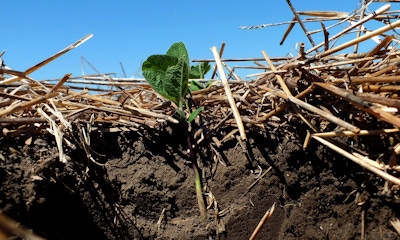June 9, 2016

The soil growing our food is rarely in the spotlight, but is gaining new recognition for its ability to store carbon. Agriculture produces received a nod at the U.N. Climate Change Conference in December 2015 for their role in sequestrating carbon in the soil. As crops and forage grow, photosynthesis causes them to absorb carbon dioxide (CO2) from the atmosphere into their roots and surrounding soil.

SOIL QUALITY: Biological activity helps winter wheat residue decompose to become precious organic matter that helps plants grow. A no-till field since 1990, this field has excellent organic matter under a corn-corn-broadleaf-wheat-broadleaf rotation for the last 10 years. 2011 was winter wheat with a cover crop of millet, annual ryegrass (little) and volunteer wheat. (Photo: Colette Kessler/USDA NRCS)
Agriculture is an important part of the carbon cycle through its carbon storage in soil and plants. According to a 2008 study by the U.S. Environmental Protection Agency, U.S. forest and croplands currently sequester the equivalent of 12% of the nation’s CO2 emissions from energy, transportation and industrial sectors. The worldwide potential of soil carbon sequestration may be as high as eight trillion kilograms CO2 per year, as shown by research published in the March 2016 “Nature” by Robert DeConto and David Pollard. This equals the removal of nearly 169 million cars from the road annually.
Soil carbon is increased through developing the quantity, quality and diversity of organic plant material. This also creates soil that is more productive and has higher water capacity. Every one% increase in organic matter results in 25,000 gallons of available soil water per acre. This is almost one inch of rainfall per acre (27,154 gallons). In arid regions, the soil’s water capacity is crucial for reducing irrigation needs and creating drought resiliency for crops and forage.
Keep it covered

LOOKING GOOD: Healthy soil looks dark, crumbly, and porous, and is home to worms and other organisms. (Photo: Colette Kessler/USDA NRCS)
Soil health is improved by minimizing bare ground and keeping living roots in the soil year around. This can be done through cover crops or intercropping multiple companion plant species. Along with preventing soil erosion and adding organic matter to the soil, cover crops add nutrients benefitting main cash crops.
For example, a three-year crop rotation in eastern Idaho can include winter wheat/legume interseed, followed by a legume, and then potatoes. It improves soil conditions, decreases soil diseases and provides nitrogen (N). Note sufficient N for standard potatoes is dependent on average or lower rainfall to keep soil N within reach of the shallow-rooted cash crop.
A two-year system for vegetable crops in the Pacific Northwest and elsewhere could be a winter wheat cover crop followed by sweet corn or onions. Other options include planting green peas, then a summer sorghum-sudangrass cover crop, and finishing out year two with potatoes.
It is also important to reduce soil disturbance by consolidating tillage or using no-till practices on cropland. Besides creating efficiency and reducing costs, this protects carbon-sheltering soil aggregates from disruption and creates pore space for retention and exchange of air and water.
Grass farming for soil health
Livestock producers can be described as grass farmers, marketing grass through their cattle and sheep. Healthy soil impacts paychecks at the sale barn by raising weight gain in livestock through increased grazing yields. Forage diversity of warm and cool season grasses and forbs boosts biological activity in the soil. Also correct timing and duration of grazing will increase plant vigor both above and below ground benefitting root biomass and soil organic matter.
For pastures and rangelands, short-duration, high intensity grazing increases organic matter and the rate of nutrient cycling. The needed grass bank is expanded by using a moderate stocking rate of livestock in a large herd moved frequently on a rotation system designed for sections to be rested for an entire season. This adds organic material to the soil, as well as increasing the soil’s seed bank needed after droughty periods.
Removing too much plant material through grazing causes erosion, poor germination, and shifts toward less desirable plant species. In perennial forage systems of western states, the effect is not noted immediately as perennials regrow from their roots putting less importance on germination conditions. But using too much plant matter, even when it’s dormant, still leaves soil exposed to erosion and doesn’t add organic material to expand water capacity of the soil.
Healthy soil isn’t accidental. It depends on the nutrient cycle of organic matter and plant roots, and the carbon process to renew itself. Agriculture, in turn, relies on healthy soils to produce crops and forage. This circle balances on producers harvesting crops and grazing forages while leaving organic matter and living roots, and rarely seeing the soil.
RESOURCES
Learning your dirt
Soil stability serves as a qualitative indicator of soil biological activity and nutrient cycling. For soil particles to bind together, the biological processes of organic matter and soil carbon must be renewing constantly. Therefore, unstable soil particles provide evidence of unhealthy soil.
The soil stability, or slake, test measures the stability of soil when exposed to rapid wetting. See the video below:
Soil technology tools available
The recently upgraded Web Soil Survey from the USDA Natural Resources Conservation Service provides interactive soil maps and soil information: websoilsurvey.sc.egov.usda.gov.
Free smartphone apps and Google Earth 3D maps of soil information collaborated for your GPS coordinates are available from the University of California, Davis’ Soil Resource Lab
Finding the right cover
The Green Cover Seed Company’s Smart Mix Calculator helps producers select cover crops based on their goals for a specific field or overall operation. smartmix.greencoverseed.com/
The USDA Natural Resources Conservation Service has developed a cover crop selection guide for Idaho, Oregon and Washington. It helps producers select cover crop species appropriate for their climate, soils, and the purposes of the cover crop.
You May Also Like




